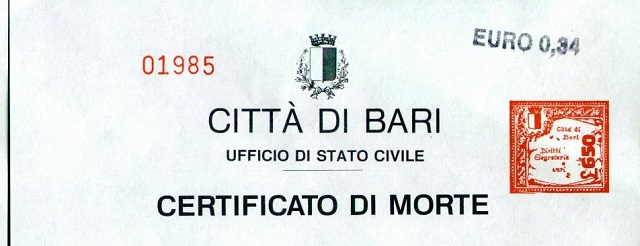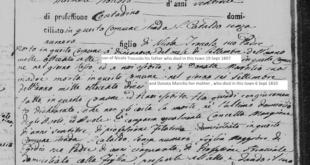We are very lucky to have Italian roots, for many reasons. From the point of view of researching one’s family tree, the major advantage of working with Italian records is that so many of them exist, are usually quite accurate, and can be acquired without flying all the way to Italy.
Imagine how difficult it would be if the only way you could get a copy of your grandfather’s birth record from Italy would be to fly to Italy and go to the civil records office and request one. They won’t give you a “copy.” Instead, they give you a rewritten “estratto.” So the irony is that you can get a copy of the original record from the internet but not from the civil records office in Italy!
Yes, you could write letters to the civil records office, and many of you who read this column might have done that. The civil records office, if they aren’t too busy, will write the estratto and send it to you. Perhaps they will ask for money, perhaps not. I have heard both stories many times. Perhaps they get it to you right away. Perhaps they never bother to respond. I have heard both stories many times.
So my larger point is, if you had to do this one ancestor at a time by mail, it might take weeks or months to get only one record. Or you might not get the record at all. You have to do this for possibly two parents. Then four grandparents. Then 8 great-grandparents. Then 16 great-great-grandparents. You’re at 30 letters and possibly 30 fees to be paid. If you need marriage records to get the parents’ ages, you need to send for an additional 14 documents. Maybe by the time they get requests for the grandparents, they are already sick and tired of all this extra work! Basta!
Since we can do all this in America without involving the civil records office, no civil official gets annoyed, there’s no cost except gas for the car and your time, and anyone can find what they need immediately if you know how to look. No waiting for the international mail. Sounds like a slam dunk!
So if everything were that easy, why are there so many restrictions on our records?
Just because you have a car that can go 130 mph doesn’t mean you can drive down 294 at that speed without consequences. Yes there are limits to what we can access, due to legal limitations, or contracts for access to the records.
Limit #1: Privacy
Just like in the U.S., you can’t just have copies of all records for any year. If they let us grab any old record we want, inevitably someone would use that access to steal an identity and then they would have to block access to everything as an overreaction. So we should understand why you can’t get any births from Italy after 1920. (Each town may be a little different but my towns are all microfilmed but I cannot view births after 1920.) I can get to deaths and marriages as late as 1945.
Limit #2: Was it photographed/filmed?
Fortunately, my Bari province was filmed as late as 1945, and those later records were released within the past few years. Not every province has records that late. If the microfilming agreement prevented anyone from filming records that were too recent for privacy laws, then they might not have filmed them at the time. The microfilm crew would have to go back and film later records that are now ok to view. However, it isn’t just a matter of piling into a van and driving to the civil records office to film the updates. There are only so many film crews out there and they have a full schedule already. This is also true of the Chicago Archdiocese sacramental records for each parish. They filmed the church records in the mid 1980s, so they did not photograph any page that was later than 1915, and to this day, you can’t get a baptism record for a Chicago-born relative if they were baptized 1916 or later.
Then you have the situation where a book was missing when the film crew was in town. Or a mistake was made and they forgot to film an entire book. Or pages were torn out of the book and your grandfather was on that page. Or they turned two pages when they meant to turn one and missed a page. There are a multitude of reasons why a record, or a bunch of them, just got skipped. Take it from me, it is very frustrating.
Finally, there are areas in the north of Italy that did not allow anyone to film their records. There might be areas where the government stopped keeping records after Napoleon was removed from the peninsula. Perhaps the records from that area were destroyed in the war and do not exist, or the records were sent to a different archive, or the records from the local town were never copied and forwarded to the provincial archive. The good news is that supposedly 80% of Americans of Italian descent have their ancestry from the south of Italy/Sicily and a better chance of finding records. But that doesn’t make the descendants from the north of Italy very happy if no records were ever filmed.
Many records were copied (by rewriting them, not with a Xerox) and sent to provincial archives, which is where most of them were filmed. It is much easier to negotiate an agreement with one provincial official than with 45 individual mayors. Thus, most filming was done at provincial archives, and if the town never sent copies to the province, that town’s records may not be on the internet.
Limit #3: Restricted access
I have discussed this in many columns. Most Italian civil records can be viewed, but only at a FamilySearch center or affiliate library. Some records can be viewed at home. The records were filmed at different locations under different agreements. Example: my records for Bari go something like this: 1809-1900 are restricted – only viewable at FamilySearch Center or affiliate library. 1901-1929 can be viewed from home. 1930-1935 restricted. 1936-1945 from home. It doesn’t make sense. Why wouldn’t the oldest records be viewable from home, since we cannot steal an identity from a guy born in 1852? Why would a death from 1944 be available and 1844 be restricted? There must be a logical reason, but for our purposes, you have to work within the agreements they signed.
Limit #4: Readability
I wish I could show you a page from Noicattaro 1814 birth records, which were devoured by bookworms to the point where practically no recognizable ink remains. I have not seen much bookworm damage later than the 1830s but it all depends on how each archive stored its books.
Recently I wrote a column about handwriting and that column explains the fun of not being able to easily read the pages that are free of bookworms but written by people with unexpected penmanship. (I am one of those people, by the way. My handwriting is perfect, except that no one can read it!)
So the next logical question is, if there are records that should be available to us, but cannot be viewed for Limit #2 or 4, why can’t we view another copy? Mostly it is for the reason I just explained. Only one copy was ever filmed at the one archive, so if there is a better copy out there, or one that is more complete or readable, we cannot get to it.
The copies that are on FamilySearch are exactly the same images that are found on “Antenati” (the site for Italian provincial archives). So if the bookworms ate 1814 births on Familysearch, they are just as chewed on Antenati.
If there is a record you cannot find due to Limits 3, go to a FamilySearch center or Affiliate library. If you cannot find it due to Limit 2 or 4 (or Limit 1 is no longer true and you should be able to get a copy by law), then you probably need to write to the local Ufficio Dello Stato Civile of your town. (Your town may be combined with a big city today and may not have its own office anymore – check the web site for the town to get the correct address.) If there is an e-mail address, you can ask the city office the correct address to send for a single vital record. If that office has its own web page, see if it mentions a cost for requesting an estratto. At least for that record, you might be able to continue your research on FamilySearch or Antenati after you get over that one hurdle.
 Fra Noi Embrace Your Inner Italian
Fra Noi Embrace Your Inner Italian







